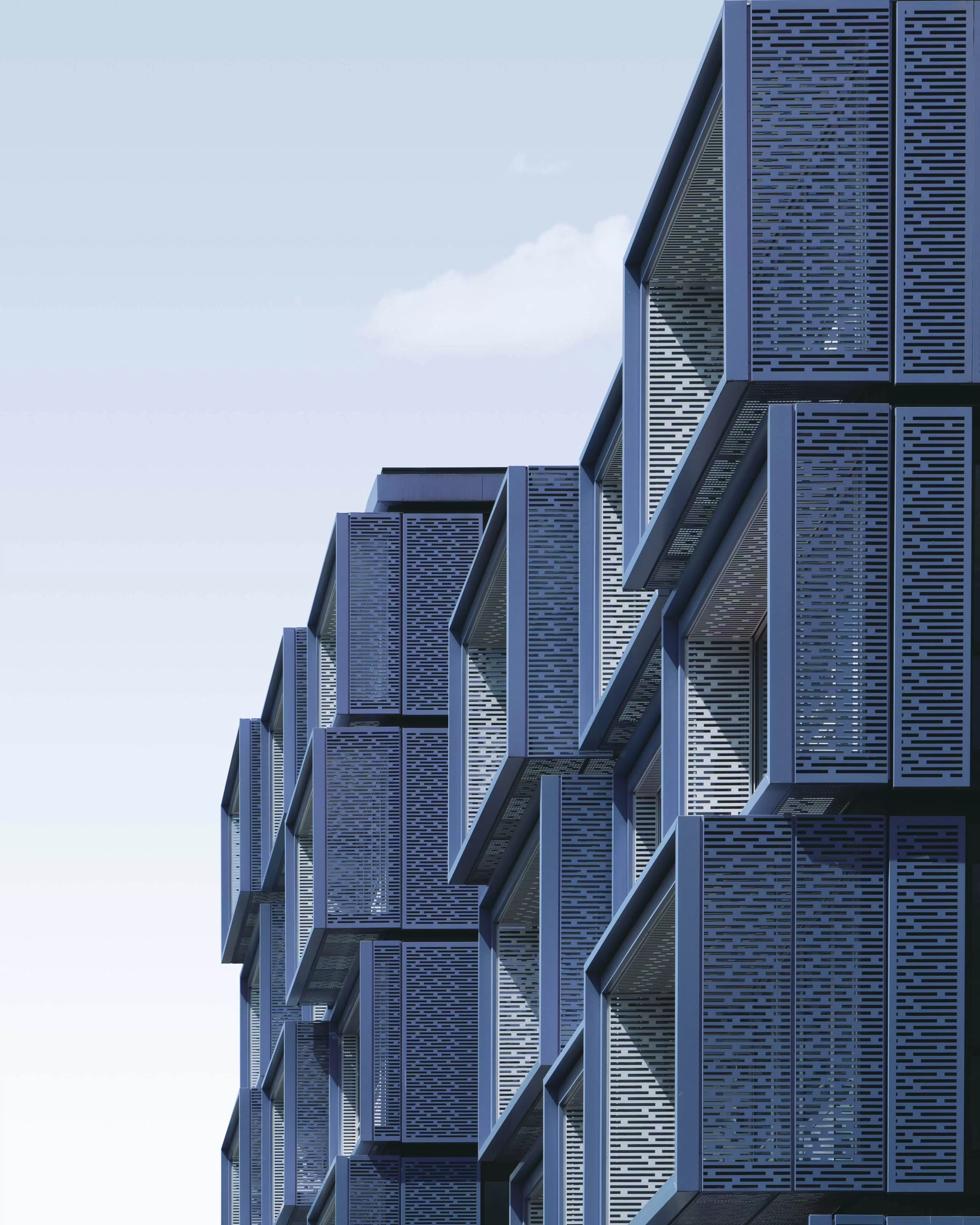Detailed content of our market study
 Inforamtion
Inforamtion
- Number of pages : 35 pages
- Format : Digital and PDF versions
- Last update :
 Summary and extracts
Summary and extracts
1 Market summary
1.1 Definition and scope of the study
The market for modular construction, also known as prefabricated construction, refers to the construction of prefabricated buildings or containers(modules) that are directly designed and manufactured in a factory and then assembled on site. Assembly makes it possible to create buildings to meet occasional or permanent needs: construction site billets, offices, as well as new forms of housing such as container houses. The modules or containers are usually made of steel, concrete , or wood, equipped with plumbing, heating, and electricity. Interior finishes are specified upon leaving the production workshop and are more or less machined according to the purpose of the building to be constructed.
Long used primarily for theconstruction industry-for site personnel in particular-modular construction has over the years become an important credible alternative to the construction ofsingle-family homes and offices.
Often, modular construction makes it possible to meet short-term needs to install buildings on a temporary basis when a building is being reconstructed or rehabilitated, but also when there is an increased need for offices or laboratories in the service sector.
Thus, modular construction is present in construction in the government sector (emergency housing, sports facilities, school premises, etc.) and in the private tertiary sector (offices, stores and kiosks, events, health, etc.). The use of prefabricated construction in the residential sector has also seen major growth in recent years.
The world market for modular construction is booming. Between 2022 and 2027, it is expected to grow at a compound annual rate (CAGR) of 5.75%, due to which the world market could reach a total value of $120.35 billion.
This rapid expansion is due to the many advantages of modular construction in terms of production costs, construction time, ease ofinstallation , and compliance with environmental constraints.
The main players in the Italian market are Edilsider, Marlegno, Damiani-Holz, Operamed and Costantini Legno. However, there are hundreds of manufacturers ranging from large multinational groups to SMEs.
1.2 The global market
Construction represents one of the world's major markets from an economic value perspective. In ****, the value of the global construction market reached $****.* billion. A compound annual growth rate (***) of *.*% is expected between **** and ****, under which the value of the market could touch a total value of more than $**** billion.
Construction Market World, ****-****, in billions of dollars Thebusinessresearchcompany
as for the modular construction industry, in **** the world market reached a total value of $**.* billion. Between **** and ****, a compound annual growth rate (***) of *.**% is expected, thanks to which the market could reach a value of $***.** billion globally.
Prefabricated construction market World, ****-****, in billions of dollars Source: ****
1.3 The Italian market
Between **** and ****, the construction market in Italy grew by **.*% thanks to a compound annual growth rate (***) while the nonresidential segment occupies the remaining **.*% or $***.* billion. Construction market Italy, ****-****, in billions of dollars Researchandmarkets As for the turnover of companies employed in building construction, between **** and **** the trend is negative (***). However, as shown in the graph below, the value of turnover is stable between **** and **** while in ****, due to the outbreak of the Covid ** pandemic, there is a *.*% decrease compared to ****. Although data for the years **** and **** are not available, it is legitimate to assume an upturn in the value of the industry's turnover brought about by the reopening of activities, the introduction of tax bonuses, and increased costs due to the outbreak of the Russian-Ukrainian conflict. This last aspect will be analyzed in Section *.*. Turnover of building construction companies Italy, ****-****, in billions of euros Istat As for the prefabricated and modular building sector, between **** and ****, the production of prefabricated buildings made of wood, plastics, concrete and aluminum grew by **.*% overall. With the sole exception of **** (***) at the difference of the construction sector. The positive trend of the industry in a period of general contraction for the construction sector indicates ...
1.4 Imports and exports
As for prefabricated buildings (***). The coverage ratio is over ***% during the entire period, with peaks up to ***% in ****.
Imports, exports and coverage ratio of prefabricated construction Italy ****-****, in millions of dollars and % Source: UN Comtrade The trade flow of prefabricated buildings out of Italy is directed to numerous countries. The one that collects the highest percentage of the value is Russia, com **.*% of the total. It is followed by France (***). The other destination countries together collect **.* percent of exports.
Largest importers of Italian prefabs ****, in millions of dollars Source: UN Comtrade By contrast, the flow of imports is more concentrated. Italy imports prefabricated buildings mainly from European partners such as Slovenia, with ** percent of the total, Germany and Austria, with **.* percent and **.* percent, respectively. This is followed by China with *.* percent of the total and the Netherlands with *.* percent. Imports from other countries account for **.* percent of the total.
Main countries from which Italy imports prefabricated buildings Italy, ****, in millions of dollars Source: ****
1.5 The consequences of the Russian-Ukrainian conflict
The outbreak of the Russian-Ukrainian conflict in February **** led to, among other things, a general increase in both the producer and consumer price index. In terms of new residential and nonresidential housing, between March **** and June ****, the housing price index (***) rose by **.* points, more than double the entire ****-**** period. This means that in the span of just over * years, the average housing price has increased by **.*% while compared to ****, the price increase stands at **%.
New housing price index Italy, ****-****, base ****=*** Istat
In the absence of precise data on the modular housing sector, it is possible to analyze the trend of cost-to-production for wood and concrete products for construction as these represent the main materials used in the construction of this type of housing. With regard to wood and carpentry products for construction, the producer price index between January **** and aogsto **** increased significantly, rising ***.* points to ***.*. This increase is reflected in a cost increase of **.* percent. Compared to ****, the production of this type of product costs **.*% more. Producer price index of other woodworking and carpentry products for the building industry Italy, ****-****, base ****=*** Istat Finally, considering concrete products, the producer price index in this one also rose significantly. During the ...
2 Demand analysis
2.1 Demand in Italy
To analyze the demand for modular homes in Italy, the evolution of the housing market in economic terms, the evolution of the number of new residential units built and the spending of Italian households on home ownership are considered. A correlation is assumed between the trend of the residential sector in general and the specific trend of modular units. Housing market **** was a virtuous year for the Italian real estate market with transactions exceeding ** billion euros in value. Compared to ****, the growth is sharp, +**%. Despite the growth recorded in both **** and ****, the figure for transactions remains lower than in **** (***). However, the data recorded over the past two years suggest that the sector is recovering. Evolution of the real estate market Italy, ****-****, billion euros Source: CBRE Number of residential units Between **** and ****, the number of residential units built during the year is on the rise (***).
New residential buildings Italy, ****-****, in thousands Istat
Household spending
Between **** and ****, Italian households' annual spending on home ownership is on the rise. During the period, spending increased from *,*** euros per year per household to *,*** euros (***).
Average annual household expenditure on owner-occupied housing Italy, ****-****, in euros Istat
In ****, the trend that younger age groups are ...
2.2 Demand drivers
key demand drivers include :
Environmental Sustainability: modular construction is recognized for its potential to reduce environmental impact. This building approach helps to reduce the environmental impact of construction while improving energy efficiency and the overall sustainability of the structure. In addition, modular construction also fits the principles of the circular economy, potentially contributing to the reduction of the carbon footprint in the construction sector, enhancing the sustainability credentials of the industry. (***) Reduced construction costs and time: modularity tends to reduce field time, thereby reducing labor costs. This approach is also more efficient in hard-to-reach locations and adverse weather conditions, improving the overall quality of execution.(***) Flexibility and reuse: modular construction offers greater flexibility than traditional construction. Modularity allows the building to be modified, disassembled and relocated, reusing its parts almost like Lego blocks. This flexibility represents a new concept of a living building, with buildings that can adapt to changing needs, which will be fundamental to modern, sustainable cities.(***) The outbreak of the Covid-** pandemic coupled with the ever-increasing frequency of natural disasters (***) has led to a rapid development in the use of modular buildings in healthcare. The main drivers related to the demand for modular construction in healthcare are: Rapid ...
2.3 Geographical distribution of demand
To highlight the geographic distribution of demand for modular homes, in the absence of specific data on this sector, a map was created with the percentage of new residential housing raised by each Italian macro-region in ****.
In ****, more than */* of new residential housing, or **,*** units, was built in the Northwest (***). Finally, just over *,*** new residential units were built in the Islands in ****, accounting for *.*% of the national total.
The following table shows the number of new residential units built in **** in each macro-region and the percentage value of them compared to the national total.
2.4 New demand trends: sustainability first
Recent trends show a growing interest in eco-friendly modular homes. The emphasis is on sustainability, with a preference for eco-friendly materials, energy-efficient solutions, and the use of renewable energy. Specifically:
Eco-friendly Materials:
Certified Wood: FSC-certified wood comes from sustainably managed forests, ensuring reforestation and protection of biodiversity. Recycled Steel: steel is one of the most recycled materials and can be reused without loss of quality. Low-carbon concrete: formulated to reduce CO* emissions during production.
Energy Efficiency:
Insulation: high-quality insulation materials reduce heat loss. High-efficiency windows: reduce heat loss and improve energy efficiency. Efficient ventilation: systems that conserve heat while providing fresh air.
Renewable energy: Solar photovoltaic panels: an increasing share of consumers are opting for a solution that includes installing photovoltaic panels on the roofs of their homes to power the home grid. Geothermal probes: these are devices used to harness geothermal energy from the subsurface. They are inserted into the ground and allow heat exchange between the subsurface and a fluid circulating within the probes. This system can be used to heat or cool buildings in an efficient and environmentally sustainable way by taking advantage of the relatively constant temperature of the ground.
(***)
3 Market structure
3.1 The market structure
In order to analyze the structure of the market, since no specific data are available for the modular construction sector alone, the macrocategory related to residential and nonresidential building construction companies (***) is taken into consideration, which is still the market in which the companies under study operate. Specifically, the number of enterprises in the sector, number of employees and breakdown of different legal forms within the sector will be analyzed.
Firms
Between **** and ****, the total number of enterprises active in the residential and nonresidential building construction sector is essentially unchanged. However, by analyzing the annual trend it is possible to show how between **** and **** the sector shows a negative trend (***) the number of enterprises is stable compared to the beginning of the period. The growth in demand as a result of the introduction of the various tax bonuses from **** is undoubtedly the main cause of the industry's recovery.
Residential and nonresidential building construction enterprises Italy, ****-****, in thousands Istat Unlike the number of enterprises, the number of employees in the sector shows no negative trend between **** and ****. In particular, there is a slight growth in the total number of employees (***).
Employment of residential and nonresidential building construction enterprises Italy, ****-****, in ...
3.2 The value chain
Design is one of the most delicate phases of the modular construction process. In fact, this is crucial in determining the quality, efficiency and sustainability of the final product. Attention to detail, technological innovation and customization are crucial to ensure customer satisfaction and project success. It is possible to break down the design phase into several sub-stages:
Use of advanced software: The use of advanced software such as AutoCad and Revit allows the drawing of forms with precision, facilitating modifications and revisions. The use of BIM (***), in addition to design, provides an intelligent *D model with structural details, materials and life cycle information. This enables better visualization, simulation and analysis of the project Customization: this phase involves the creation of modules that can be adapted to different needs, such as size, layout or interior finishes as well as continuous integration of client feedback to ensure that the design meets their needs and preferences. Certifications: it is critical to ensure that designs comply with local laws and regulations, which can vary greatly from one region to another. In addition, it is imperative to ensure compliance with specific regulations to ensure occupant safety, such as fire resistance, earthquake resistance, and others related to ...
3.3 The main manufacturers
A list of leading Italian manufacturers is offered below:
Kager: is Italy's leading company in the construction of high-quality prefabricated wooden houses, with an approach that combines high construction technology, craftsmanship and state-of-the-art energy solutions. Kager specializes in total project customization, with over ** years' experience in building wooden houses throughout Europe and a research and development department that works to continuously perfect the product.
Modularee s.r.l: founded in ****, the company specializes in the design and construction of eco-sustainable buildings, made with wood-based, low-energy bio-architecture. Modularee's mission is to combine wellbeing and living comfort, creating the right balance between man and the environment, always emphasizing and stressing the importance of energy saving (***) and environmental sustainability.
Homy Build: is a company specializing in modular construction based on prefabricated steel-frame lightweight steel system. It represents the ideal partner for General and EPC Contractors, Oil & Gas companies and industrial maintenance, real estate, architects and designers, thanks to its ability to tackle each project with concreteness, flexibility, engineering know-how at the highest level and manufacturing partnerships with widespread presence in the five continents.
Edilsider: founded in Italy in ****, has fifty years of experience in the field of prefabricated modular metal buildings and today has ...
4 Supply analysis
4.1 Type of the offer
The prefabricated construction system is based on the construction of a wood, metal, concrete or mixed structure, made in * or * dimensions and which can be prefabricated (***). They can also be stacked to obtain multiple floors.
This system is based on the fabrication of modular elements that take place between ** and **% in the workshop, including, depending on requirements, a water or air finish, including all technical steps and finishes. The remaining ** to ** percent is completed on-site to assemble the modules, adapt them to site constraints, and customize them to the visual and technical constraints of the project[***].
Different types of prefabricated construction as needed
The most common prefabricated construction, which has been the forerunner of modular construction since the ****s, consists of rectangular modules, and sandwich panels, which consist of a steel skeleton on which prefabricated panels are installed.
There are different types of prefabricated structures depending on the industry:
Constructions for the construction industry are generally modular construction site bungalows (***), construction site offices, and construction site trailers; Event constructions, temporary health care facilities or prefabricated reception rooms (***); Buildings for the medical professional are outdoor testing laboratories, blood donation centers, and also medical offices; Buildings for the service sector include retail store ...
4.2 The prices
Due to the outbreak of the Russian-Ukrainian conflict in February ****, the indexes of producer prices and consumer prices experienced not insignificant positive changes. Regarding the residential and nonresidential building construction sector, the producer price index increased by * points, which is reflected in a * percent increase in costs. Compared to ****, producer prices for this industry rose by **.*%.
Output price index of residential and nonresidential building construction Italy, ****-****, base ****=*** Istat
Modular construction
(***)
Unfinished: an unfinished house is a house in which only the wooden structure of the building is built, i.e., walls, floor and roof, complete with load-bearing structure and insulation with coat. stano therefore excluded from the supply the roofing and the interior and exterior finishes (***). Also missing are the sheet metal elements, which are usually made and installed at the same time as the roofing membrane and roof. Advanced unfinished: in an advanced unfinished house, there are the prefabricated walls, the finished and shaved exterior coat, the roof complete with roofing membrane, the elements of guttering, the window and door frames, and the shading. Normally, in most cases (***) already at the advanced rough-hewn stage, the arrangements for plumbing with corrugations are required and present. Semi-finished: houses in a ...
4.3 New supply trends: 3D printing
*D printing in modular home construction enables efficient production, reducing time and costs. With *D printing, custom components can be created in a controlled environment, reducing errors and material waste. This technology also facilitates the creation of complex architectural designs that would be difficult or expensive to achieve with traditional methods. *D printing is a step toward modernizing the modular construction industry, making manufacturing more agile and sustainable. Specifically, key aspects related to *D printing in the modular construction industry are:
Off-Site Manufacturing: *D printing enables the production of modular components in a controlled environment (***), which can then be transported and assembled on-site. This approach reduces construction time, cost, and environmental impact. Custom Designs: *D printing technology allows for greater design freedom, facilitating the creation of complex, custom shapes that would be difficult or expensive to achieve with traditional methods. Efficiency and waste reduction: *D printing is known for its material efficiency, as it uses only the amount of material needed to create a component, thus reducing waste Sustainable materials: *D printing can use a variety of sustainable or recycled materials, helping to reduce the environmental impact of modular construction. Rapid response to housing crises: due to the speed of production, ...
5 Rules and regulations
5.1 The legislation
https://www.altalex.com/documents/codici-altalex/****/**/**/testo-unico-in-materia-edilizia
6 Positioning of actors
6.1 Segmentation
Residential segment
Healthcare segment
- Lignoalp (Damiani-Holz & Ko)
- Technowood s.r.l
- Ecohouse s.r.l
- Costantini Legno s.r.l
- Marlegno s.r.l
- Edilsider s.r.l
- Homy Build s.r.l
- Modularee s.r.l
- Kager s.r.l
- Speed Hospital s.r.l (Adam s.r.l)
- Mangini s.r.l
- Operamed
All our studies are available online in PDF format
Take a look at an example of our research on another market!
 Choosing this study means :
Choosing this study means :
Access to more than 35 hours of work
Our studies are the result of over 35 hours of research and analysis. Using our studies allows you to devote more time and added value to your projects.
Benefit from 6 years' experience and over 1,500 industry reports already produced
Our expertise enables us to produce comprehensive studies in all sectors, including niche and emerging markets.
Our know-how and methodology enable us to produce reports that offer unique value for money.
Access to several thousand articles and paid-for data
Businesscoot has access to all the paid economic press as well as exclusive databases to carry out its market research (over 30,000 articles and private sources).
To enhance our research, our analysts also use web indicators (semrush, trends, etc.) to identify market trends and company strategies. (Consult our paying sources)
Guaranteed support after your purchase
A team dedicated to after-sales service, to guarantee you a high level of satisfaction. +44 238 097 0676
A digital format designed for our users
Not only do you have access to a PDF, but also to a digital version designed for our customers. This version gives you access to sources, data in Excel format and graphics. The content of the study can therefore be easily retrieved and adapted for your specific needs.
 Our offers :
Our offers :
the modular construction market | Italy
- What are the figures on the size and growth of the market?
- What is driving the growth of the market and its evolution?
- What is the positioning of companies in the value chain?
- Data from several dozen databases
5 reports pack (-15%) IT Italy
- 5 reports at €75.6 excluding VAT per study to choose from our Italian catalogue for 12 months
- Save 15% on additional studies purchased
- Choose to be refunded any unused credit at the end of the 12-month period (duration of the pack)
See the terms and conditions of the pack and the refund of unused credit.















